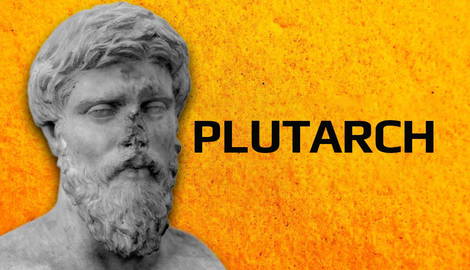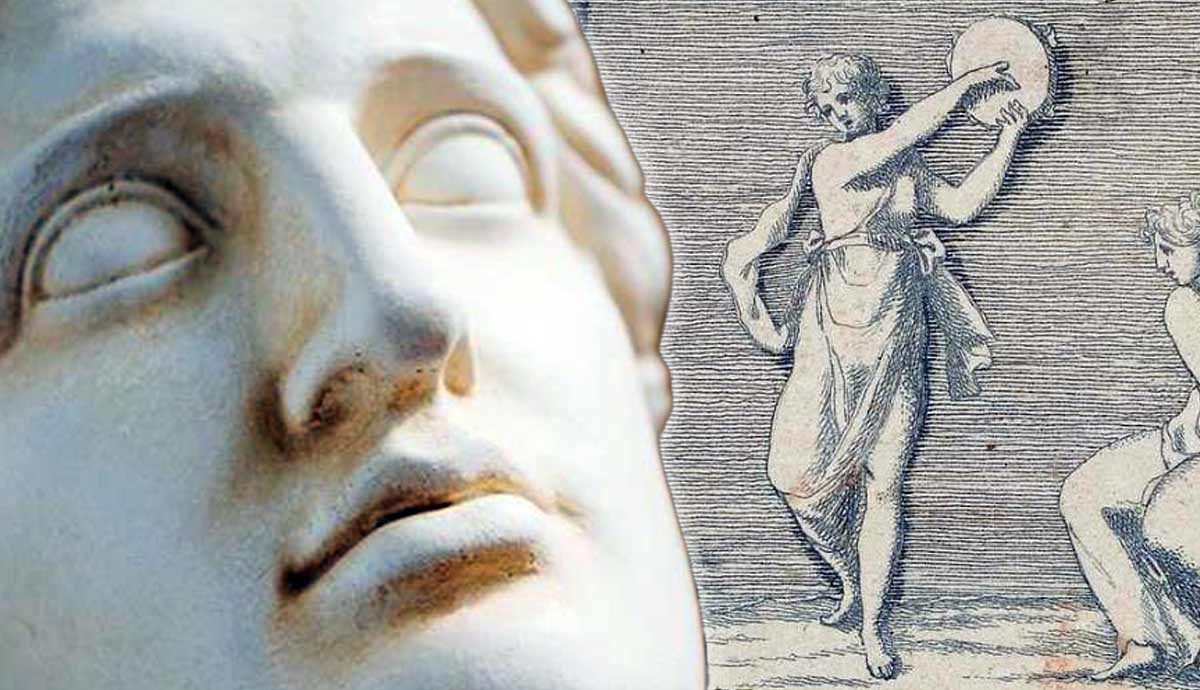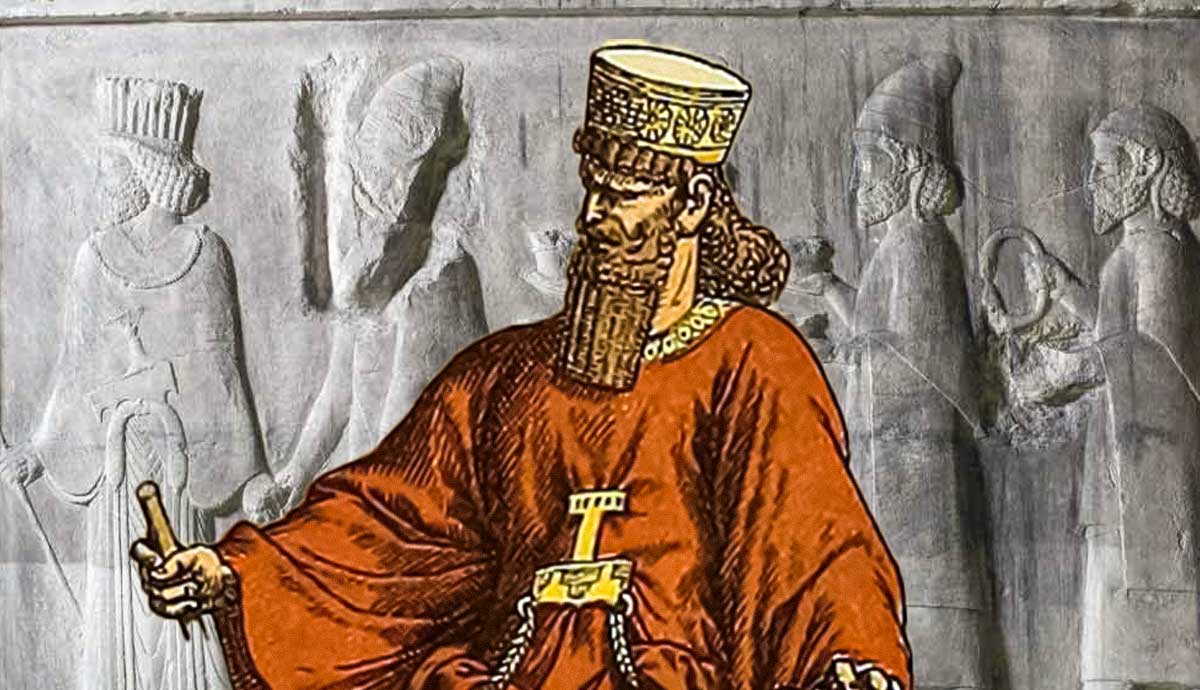
Every student of ancient history has heard the name Plutarch, whose extensive collection of biographies of important figures from Greek and Roman history has become part of the standard curriculum. While he was a prolific writer, his most famous work is his Parallel Lives, in which he compared figures with similar stories from both sides of the Adriatic Sea, for example, comparing the Greek king Alexander the Great and the Roman general Julius Caesar. More focused on the characters of the individuals than historical events, Plutarch’s account provides “color” to our picture of the ancient world. But who was Plutarch, why did he write his biographies, and how reliable is he as a source for the ancient world?
Who Was Plutarch? Member of the Greek Elite

Plutarch, born in Chaeronea near Delphi in 40 CE, was a typical member of the Greek elite living under the Roman Empire. As a young man, he was sent to Athens to study oratory and philosophy under the popular teacher Ammonius. Plutarch was known to be a Platonist and produced several philosophical works.
In his early 20s, Plutarch was a member of the local elite who attended the games at Delphi in which the Roman emperor Nero competed in 66-67 CE. Certain Greek games were postponed so Nero could participate in all four Panhellenic Games while traveling in Greece.
Plutarch gained Roman citizenship at some point, suggesting that he served Rome in some way, probably in an administrative capacity. An inscription at Delphi reveals that his sponsor was Lucius Mestrius Florus, a friend and associate of the emperor Vespasian. Plutarch is also known to have visited Rome near the start of Vespasian’s reign, where he seems to have rubbed shoulders with members of the aristocracy.
A member of the local elite, Plutarch became a priest of the Temple of Apollo at Delphi in around 95 CE. A bust of Plutarch was dedicated there and inscriptions indicate that he oversaw renewed construction around the site funded by local elites, including Plutarch and his family. He later served as a magistrate in his hometown of Chaeronea, including as archon (chief magistrate). Between 107 and 127 CE, he served as manager of the Amphictyonic League, which organized the Pythian Games at Delphi five times.

Less reliable sources suggest that the emperor Trajan made Plutarch the procurator of Illyricum and that Hadrian made him nominal procurator of Achaea. These posts seem unlikely, not least because Illyricum was not a procuratorial province, but it shows that in the centuries following Plutarch’s death, during which his written works were studied, he was perceived as being an imperial favorite who served the Roman Empire. Plutarch’s popularity after his death is attested by Apuleius (c. 124-170 CE) who made a fictional version of a descendant of Plutarch the protagonist in his Golden Ass.
Married to Timoxena, Plutarch had at least four sons and one daughter, though at least one son and daughter died in infancy, as attested by a letter from Plutarch to his wife. His family can be traced in Greece until the 4th century CE and included several other philosophers and authors.
Plutarch the Biographer

Plutarch is best known for his collection of Parallel Lives, in which he chose illustrious figures from the history of Greece and Rome with similar stories and composed parallel and comparative biographies of each pair. It is important to note that these are biographies rather than histories. Plutarch informs the reader of this in the introduction to his Life of Alexander the Great, suggesting that it was intended to be read first in the series of Parallel Lives.
“… in case I do not tell of all the famous actions of these men, nor even speak exhaustively at all in each particular case… For it is not Histories that I am writing, but Lives; and in the most illustrious deeds there is not always a manifestation of virtue or vice, nay, a slight thing like a phrase or a jest often makes a greater revelation of character than battles when thousands fall, or the greatest armaments, or sieges of cities.” (Plutarch Life of Alexander the Great 1.1-2)
The Parallel Lives were also not the first biographies Plutarch wrote. Under the Flavian emperors (69-96 CE), he wrote biographies of the Roman emperors from Augustus to Vitellius. Sadly, very little survives: only his biographies of Galba and Otho and fragments of his works on Tiberius and Nero.

Nevertheless, what does survive is interesting for several reasons, one being that it parallels Tacitus. He was a Roman senator and historian who covered Tiberius to Nero in his Annals and the civil war of 69 CE and the Flavians in his Histories. This was clearly the moment that it was finally considered safe to reflect on the first century of the empire—Tacitus from the perspective of a Roman senator and Plutarch from the perspective of a Greek elite. Consequently, it is interesting to note where their accounts differ.
Tacitus praised Julius Caesar for his military genius but criticized his ambition and disregard for the institutions of the Republic. Plutarch sees him more as a visionary leader who extended the borders of what was possible, like Alexander the Great. Plutarch also paints a generally positive picture of Tiberius, while Tacitus focuses on his cruelty and suspicion. Tacitus paints Nero as a thoroughly spoiled, cruel, ruthless, and selfish imperial prince, while Plutarch, who encountered Nero on his tour of Greece, praises his intellect and vision for the future of Rome.
These differences provide some insight into where history and opinion meet in the works of both authors and hint at the different legacies of important figures on both sides of the Adriatic Sea. For example, Nero retained popularity in the east after his death, and several false-Neros emerged to make power grabs.
Parallel Lives

The Parallel Lives are Plutarch’s most famous biographies, and a significant portion of them survive. 23 pairs of biographies survive and an additional four single biographies, which were surely meant to be paired but their partners have been lost. We know of a few biographies that existed in ancient times but have not survived, including those of Heracles, Philip II of Macedon, Epaminondas, one of the Scipios, and Quintus Caecilius Metellus Numidicus.
Below is a list of the parallel biographies that we know Plutarch wrote, including who they were and why they were considered parallel. Modern commentators believe that Plutarch sometimes stretched the truth to make his subjects appear more similar, even claiming that they looked similar and that certain physical features reflected personality traits. Although it is clear that Plutarch has taken some liberties, he reflected how these figures, considered famous in the 1st century CE, were perceived at the time.
Theseus and Romulus

Theseus (c. 8th/9th century BCE) is a hero from Greek mythology who infamously slayed the Minotaur. He is also considered a founding father of Athens, credited with uniting Attica under Athenian rule. He is compared to the legendary Romulus (c. 8th century BCE), a descendant of the Trojan hero Aeneas, who founded the city of Rome.
Lycurgus and Numa Pompilius

Lycurgus (c. 390-324 BCE) was the legendary lawgiver of Sparta who created Sparta’s military-oriented society based on the guidance of the Delphic Oracle. Numa Pompilius (c. 753-672 BCE) was the pious second king of Rome credited with establishing most of Rome’s fundamental religious institutions. Plutarch describes them both as humble and pious leaders.
Themistocles and Camillus

Themistocles (c. 524-459 BCE) was a non-aristocratic popular politician who rose to power during the early days of Athenian democracy. He convinced the Athenians to build their naval fleet and fought the Persians at the Battle of Marathon. Marcus Furius Camillus (c. 446-365 BCE) was a Roman Republican statesman who defended Rome from being sacked by the Gauls.
Solon and Publicola

Solon (c. 630-560 BCE) was one of the founding fathers of Athenian democracy who passed laws and made constitutional reforms to prevent economic and moral decline. Publius Valerius Publicola (c. 503 BCE) was one of the four Roman aristocrats who led the overthrow of the Roman kings and served as one of the first two consuls of the Republic.
Pericles and Fabius Maximus

Pericles (c. 495-429 BCE) led Athens at the start of the Peloponnesian War and turned the Delian League into an Athenian Empire. He is credited with most of the surviving buildings on the Athenian Acropolis, including the Parthenon. Quintus Fabius Maximus Verrucosus (c. 280-203 BCE) served as Roman consul five times and as dictator twice, and he led the Romans during the Second Punic War against Hannibal. Plutarch compared their military and civil excellence.
Alcibiades and Coriolanus

Alcibiades (c. 450-404 BCE) was an Athenian military commander during the Peloponnesian War. He defected to Sparta and then Persia, helping Athens’s enemies before returning to Athens. Gnaeus Marcius Coriolanus (c. 5th century BCE) was a Roman general who led the Roman offensive against the Volsci before being exiled from Rome and leading the Volsci to besiege Rome.
Epaminondas and Scipio Africanus (or Aemilianus)

Epaminondas (c. 4th century BCE) led Thebes to throw off Spartan subjugation and reshaped the Greek political landscape, creating a Thebean hegemony. Only references to the life that paralleled Epaminondas survive, and it is unclear whether it was the life of Scipio Africanus (c. 236-183 BCE) of the Second Punic War, or Scipio Aemilianus (c. 185-129 BCE) of the Third Punic War.
Phocion and Cato the Younger

Phocion (c. 402-318 BCE) was an Athenian politician known for his commitment to extreme frugality. His strong moral code often put him in conflict with his political colleagues. Cato the Younger (c. 95-46 BCE) was a Roman politician known for his frugality and Stoicism who advocated for traditional Roman values. He vehemently opposed the growing power of generals like Caesar and Pompey.
Agis and Tiberius Gracchus

The Spartan king Agis IV (c. 245 BCE) passed laws to cancel debt and redistribute land to combat rising inequality. This resulted in widespread violence, and he was accused of tyranny and executed. Tiberius Sempronius Gracchus (c. 164-133 BCE) was a Roman tribune of the plebs who passed agrarian reforms that transferred land from the wealthy to poor citizens. His proposals challenged senatorial power and were blocked, leading to violence and his assassination.
Cleomenes and Gaius Gracchus

The Spartan king Cleomenes (c. 219 BCE) organized the Greek resistance to the Persian Empire under Darius just before the Persian War. He was later declared insane, imprisoned, and died. The younger brother of Tiberius, Gaius Sempronius Gracchus (c. 154-121 BCE) was also a tribune of the plebs who tried to pass populist policies leading to broad unrest, martial law, and Gracchus’s death.
Timoleon and Aemilius Paullus

Timoleon (c. 411-337 BCE) was an aristocrat from Corinth who assassinated his brother as a tyrant and then overthrew a tyranny in Syracuse. Lucius Aemilius Paullus Macedonicus (c. 229-160 BCE) was the consul who captured Macedon for Rome. Plutarch notes that they were both known for the integrity with which they conducted their affairs.
Eumenes and Sertorius

Eumenes (c. 362-316 BCE) was a Greek who served Alexander and became embroiled in the successor wars until he was betrayed by his own men. Quintus Sertorius (c. 123-72 BCE) led a rebellion against the Senate in Spain, holding much of the Peninsula for almost a decade before he was assassinated by his own men. Plutarch describes them both as outsiders who found leadership positions.
Aristides and Cato the Elder

Aristides (c. 530-468 BCE) was an Athenian general during the Persian War who founded the Delian League and advocated for continued action against Persian aggression. Cato the Elder (c. 234-149 BCE) was a famous Roman statesman best known for his continued calls for Carthage, Rome’s long-time enemy, to be destroyed. Plutarch compares their unwavering denunciation of their enemies.
Pelopidas and Marcellus

Pelopidas (c. 364 BCE) was a Theban statesman responsible for undermining the Spartans and establishing the Theban hegemony. Marcus Claudius Marcellus (c. 270-280 BCE) killed the Gallic king Virifomarus in single combat and conquered the fortified city of Syracuse. Plutarch notes that both were valiant and daring, but while Pelopidas offered his enemies mercy, Marcellus offered slaughter.
Lysander and Sulla

Lysander (c. 454-395 BCE) was the Spartan leader who destroyed the Athenian fleet, ending the Peloponnesian War and securing Spartan domination of Greece for the next decade. Lucius Cornelius Felix Sulla (c. 138-78 BCE) was a Roman general who engaged in Rome’s first major civil war against Gaius Marius, marching on Rome and making himself dictator to secure his interests.
Pyrrhus and Marius

Pyrrhus of Epirus (c. 319-272 BCE) was one of Alexander’s successors and led the Greek resistance to Roman expansion. His military victories often came at great cost, coining the term Pyrrhic victory. Gaius Marius (c. 157-86 BCE) was a Roman consul seven times and triumphed in the Jugurthine and Cimbrian wars, but his reputation was damaged by the civil war with Sulla.
Philopoemen and Titus Flaminius

Philipoemen (c. 253-183 BCE) was a general of the Achaean League known for reforming their military efficiency. Titus Quinctius Flaminius (c. 229-174 BCE) was a Roman leader instrumental in the defeat of Macedon and Sparta, allying with the Achaean League and expanding Roman interests in Greece. These are the only lives where the two characters crossover and meet.
Nicias and Crassus

Nicias (c. 470-413 BCE) was an extremely wealthy Athenian prominent during the Peloponnesian War. Following a series of military disasters, he was executed by the Syracusans. Marcus Licinius Crassus (c. 115-53 BCE) was known as the richest man in Rome, who put down the slave revolt of Spartacus and was part of the first triumvirate. He lost his life during a disastrous military expedition to Parthia.
Cimon and Lucullus

Cimon (c. 510-450 BCE) was an Athenian leader active during the Persian Wars, instrumental in the formation of the Delian League. Made wealthy by his military exploits, he funded many Athenian building projects. Lucius Licinius Lucullus (c. 118-56 BCE) was a successful general during the Third Mithridatic War who returned to Rome with so much booty that he became a major philanthropist.
Dion and Brutus

Dion (c. 408-354 BCE) expelled the tyrant Dionysus I of Syracuse and became master of the city, only to alienate the population with his imperious behavior, resulting in his execution. Marcus Junius Brutus (c. 85-42 BCE) led the senatorial assassination of Caesar and was driven from Rome for his actions. Plutarch says that both were honored by their enemies and vilified by their friends.
Agesilaus and Pompey

Agesilaus II (c. 400-360 BCE) was the king of Sparta during the early years of the Spartan hegemony following the Peloponnesian War, later vilified for failing to protect Sparta from the Theban Hegemony. Pompey Magnus (c. 106-48 BCE) was one of Rome’s most celebrated generals, celebrating three triumphs, but later criticized for failing to defend the Republic against Caesar.
Alexander the Great and Julius Caesar

Alexander the Great (c. 356-323 BCE) was a legendary general who conquered an empire from Greece to Asia. His untimely death led to years of civil war among his successors. Gaius Julius Caesar (c. 100-44 BCE) was one of Rome’s most renowned generals, conquering Gaul and then conquering Rome and installing himself as dictator. His assassination led to years of civil war.
Demosthenes and Cicero

Demosthenes (c. 384-322 BCE) was one of Athens’s most famous orators and a staunch opposer of Macedon’s expanding power under Philip and Alexander, leading to his forced suicide. Marcus Tullius Cicero (c. 106-43 BCE) was one of Rome’s most famous orators and staunchly opposed both Caesar and Mark Antony, leading to his forced suicide.
Demetrius and Mark Antony

Demetrius I Poliorcetes (c. 337-283 BCE) was a successor of Alexander who changed allegiances frequently before making himself king of Macedon. He was then overthrown and imprisoned. Mark Antony (c. 83-30 BCE) rose to power as Caesar’s right-hand man and then battled for dominance of Rome and lost. Plutarch characterizes both as driven by personal desires.
Moralia: Other Surviving Works

While the Parallel Lives are Plutarch’s most important and extensive surviving works, he was a prolific writer. The Catalogue of Lamprias records 227 works, 78 of which survive, including mostly essays and transcribed speeches. Some works are whimsical, like his treatise Concerning the Face Which Appears in the Orb of the Moon and his dialogue between Odysseus and one of Circe’s pigs. However, most of his works concern serious moral questions, such as On Fraternal Affection, On the Decline of Oracles, On the Delay of Divine Vengeance, and On Peace of Mind. This is why his works are collectively called the Moralia.
In his works, he reflects his Platonian philosophy, including a belief in a divine soul and reincarnation. He also shares his thinking on religion as a priest at Delphi, exploring how oracles give their prophecies and the reasons for the differences between Greek and Roman religious practices. He also criticizes the historian Herodotus extensively, seemingly for Herodotus’s criticism of some of the Greek city-states that fought against Persia. Plutarch was also the first to frame the “chicken and egg” problem in its modern form.

But just as Plutarch’s essays focus on providing moral instruction and guidance, so do his Parallel Lives. He uses these great men of history as examples of the result of virtue versus ambition. He specifically states that he hopes readers will be driven to emulate some of these great men, though he is less explicit in stating which are to be praised and which are to be condemned.
Therefore, when Plutarch tells his readers that he is not producing histories, but lives, he is still being a bit disingenuous. He is creating characters for moral, didactic lessons. Nevertheless, Plutarch is our main source for many of these important figures, making him incredibly important to history. In fact, the value we place on many of these figures is a direct result of Plutarch’s choosing to write about them.











